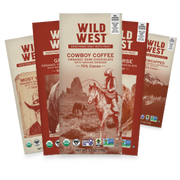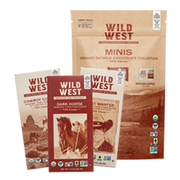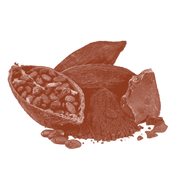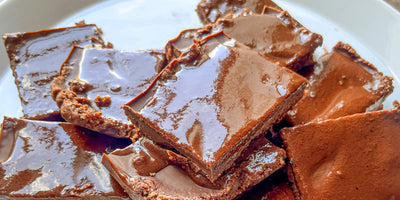You may know your way around dark, milk, and white chocolate, but what about cacao vs. cocoa? Chances are you’re not exactly sure what sets them apart from each other.
The two ingredients actually come from the exact same place: the Theobroma cacao tree. Typically found in Africa, South America, Asia, and parts of North America, these trees are grown by more than 50 million farmers around the world, according to the American Geographical Society. West Africa currently harvests three-quarters of the world’s supply.

As they mature and ripen, cacao trees produce fruit in the form of pods, each containing 20 to 60 seeds — also referred to as cocoa beans (the seeds look a bit like a coffee bean). Raw, the beans taste like a very bitter version of chocolate, and the flavor profile can be different based on the variety of plant, the soil it was grown in, exposure to sunlight, and other factors.
The beans are harvested and processed to varying degrees to create cacao and cocoa. And though both form the basis for what eventually becomes chocolate, their similarities pretty much end there.

So what distinguishes the two chocolate powders cacao vs. cocoa, other than a few letters? Turns out, quite a bit. From flavor to how they're made to the benefits they offer, there are some fundamental differences between the two. Here's what sets cacao and cocoa apart and how to cook with these two ingredients.
What's the difference between cacao and cocoa?
Simply put, cacao refers to the minimally processed form of the cacao bean, while cocoa refers to the highly processed form of the bean. Cacao beans are harvested from the tree, and the beans are fermented to develop their flavor before being left to dry in the sun. At this point, the chocolate-makers have to make a choice between whether to roast the beans first, or just use the raw beans.

Cacao is unsweetened and minimally processed and comes in the form of nibs, paste and powder. Cacao nibs are the crushed form of (air dried) cacao beans and are often used to add texture to food without a lot of flavor. They provide a nut-like consistency, without introducing allergens.
For cacao powder, which is often labeled as "Raw Cacao Powder" — and how cacao is most often used — the nibs are ground to make a cacao liquor (aka cacao mass). This substance contains both cocoa solids, which give chocolate its characteristic flavor, and cocoa butter (a white, fatty substance that tastes like white chocolate), which contributes to the texture. This is then cold-pressed to separate the cacao butter from the cacao solids. Once the fats have been mostly removed, the cacao solids are ready to be milled into a fine, dark, semi-sweet powder.
Cocoa looks the same but it’s not. The most popular form of cocoa is cocoa powder, the stuff that most of us are used to cooking and baking with. Cocoa powder is raw cacao that’s been roasted at high temperatures and typically supplemented with additives to cut the bitterness (either an alkalizing chemical solution in the case of Dutch-processed or alkalized cocoa, or with sugar and other additives, as found in milk chocolate and candy chocolate bars). The time and temperature that the beans are roasted influences the flavor of the cocoa, removing some of the acidic notes and helping the bright, chocolate-forward flavors develop.
Nutritional Benefits
Because it’s been processed at such low temperatures, cacao maintains the nutritionally dense properties of the cacao seed, making it an excellent source of nutrients. Cacao is an excellent source of monounsaturated fats, cholesterol-free saturated fats, vitamins, minerals, fiber, natural carbohydrates, protein, along with more antioxidants than most fruits and veggies. Cacao powder contains nearly four times the antioxidant power of cocoa powder—and more than 20 times the amount found in blueberries.
Antioxidants help to protect cells from free radical damage that occurs as the result of daily exposure to toxins, stress, sun damage, and inflammation. This sweet superfood also contains several minerals that support the circulatory system, including magnesium, copper, potassium and calcium, which have been shown to help reduce the risk of hypertension and atherosclerosis.
It also contains a high amount of flavonoids, specifically flavanols, which have antioxidant properties.
Consuming flavonoids may support a reduced risk of many chronic diseases, including cancer, cardiovascular disease and neurodegenerative disorders. The high-heat processing involved making cocoa strips the beans of most of their nutrients. The remaining nutrients depend on the variety of cacao bean, geographic origin, heat and chemicals used during processing. Surprisingly, it still retains a large amount of antioxidants, packing a powerful antioxidant punch, and is still excellent for your heart, skin, blood pressure, and even your stress levels. It also contains polyphenols and some flavanols.
To get the health benefits of cocoa powder, buy unsweetened cocoa powder with no ingredients added. It has fewer calories, less fat and sugar and more antioxidants than chocolate powder. Just make sure to read the label, as it will tell you if the product contains cocoa or chocolate.
Cooking with these 2 ingredients
Both ingredients are used for a variety of things. Whole cacao beans are best enjoyed roasted and you can snack on them as-is or use them as a crunchy topping (think oatmeal or smoothie bowls). Cacao nibs are basically crushed beans—use them like you’d use a chocolate chip.
Cacao powder is great for making hot chocolate or to add some chocolatey goodness to oatmeal or protein shakes. It can also be used in savory dishes, like on a dry rub for steak, and is often used in the Mexican sauce, mole, to give a smokey flavor.
Usually, cocoa powder is what’s used in conventional baking and is used to make killer cakes, brownies, cookies and ice cream. It is also frequently added to coffee.

Can you substitute cacao for cocoa? You can certainly use cacao powder in your baked goods, but it is considerably more expensive. Also, because cacao powder is less processed than cocoa powder, it has a have a more intense flavor and is a lot more bitter. It's also important to note that cacao powder is acidic; most unsweetened cocoa powder at the supermarket is also naturally acidic, but Dutch process cocoa powder is not, so it won't react with baking soda —keep this in mind if you're making any swaps. In addition, cacao powder has more starch than cocoa powder, which makes it more absorbent, so you might want to use slightly more liquid to prevent your cake or brownies from drying out. Finally, know that baking is similar to processing, in that it subjects the cacao to high heat and destroys some of the nutrients. If you're looking to get all the health benefits of cacao, your best bet is to consume it raw.
The Final Scoop
There you have it! Now you can school everyone you know on the differences between cacao and cocoa powder. And although cacao wins in terms of nutrients and health benefits, cocoa powder still takes the cake when it comes to all your baking needs.
 Bars
Bars
 Bear Claws
Bear Claws
 Merch
Merch
 Variety Packs
Variety Packs
 Shop All
Shop All
 Our Story
Our Story
 Sustainability
Sustainability
 Ingredients & Certifications
Ingredients & Certifications
 Artist Collaborations
Artist Collaborations
 FAQs
FAQs







